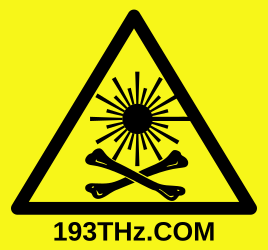
The region of the electromagnetic spectrum around 193THz (corresponding to the better-known 1550nm telecom wavelength) is the world's largest photonic playground. Thanks to the wide availability of cost-effective, performant and easy-to-use optical components operating at this particular frequency, advanced experimentation, learning and prototyping in photonics becomes possible without a small team, a massive pile of cash to burn through, and the patience of a saint. In fact, it becomes a fun and rewarding activity.
Still, high-quality and practical information about this domain remains rare and difficult to find. This website documents my own explorations and experiments in this area. It will also cover atomic and quantum physics topics - my interest in laser technology comes from my experience as the lead developer of the ARTIQ control system originally designed for trapped-ion and ultracold atom experiments, trying to reproduce some such experiments myself (as one does), and being constantly put off by problems related to lasers which are a central component of those experiments: poor performance, proprietary unserviceable designs, unobtainium parts, unreliability, user-hostile design, and stratospheric prices which in combination with the other issues always make you feel like you are being ripped off. Even Germany's Federal Ministry of Education and Research generally appears to agree. Certainly, there must be a better way of doing these things!
This website is by no means limited to experiments around the 193THz optical frequency, the name is simply a tribute to this great enabler.
The content assumes that you are already familiar with the general theory and practice of lasers, as well as related fields such as electronics and signal processing. If you are not, the excellent Sam's Laser FAQ is a good place to start. The RP Photonics Encyclopedia is another great resource with concise and accurate articles that include more advanced concepts, though they are written from a more formal and theoretical standpoint. For the practical aspects of working with fiber optics, the FOA has very detailed tutorials intended for telecom technicians. Last but not least, the book Building Electro-Optical Systems: Making It All Work by Philip C. D. Hobbs is a must-read for anyone building any kind of non-trivial laser system.
Experiments on this website involve, among other hazards, high voltage at dangerous and possibly lethal levels, vacuum vessels that can implode and project glass shards, and visible or invisible laser beams that can cause permanent eye damage, burn skin, and start fires. Optical fiber scraps produced during splicing can cause injury. Make yourself familiar with the hazards and take appropriate control measures. Information is provided here in good faith but "as is" and without any warranty; use it entirely at your own risk.
Opinions expressed on this website are my personal opinions and do not represent the position of M-Labs Limited or any other organization.
You have permission to use, copy, modify, and distribute the original content from this website for any purpose with or without fee, provided that attribution to 193THz.com and this permission notice appear in all copies.
I can be contacted regarding these articles at root@193THz.com. I can't be bothered to submit anything to academic journals as some people have suggested, but in lieu of peer review, I will publish any intelligent technical comments.